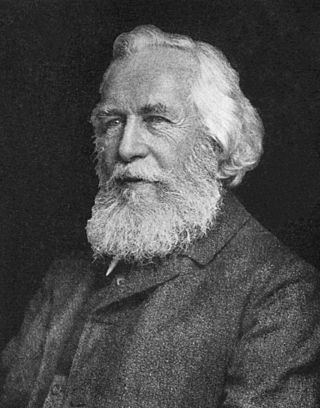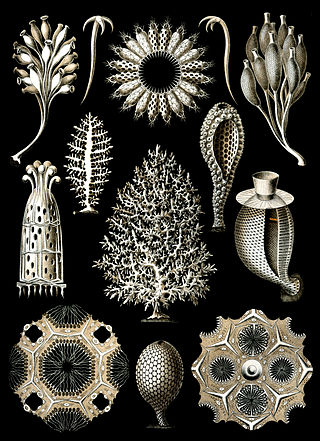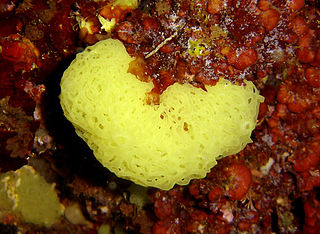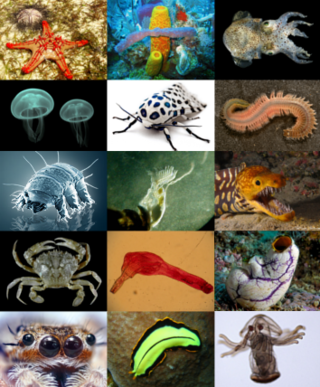
Ernst Heinrich Philipp August Haeckel was a German zoologist, naturalist, eugenicist, philosopher, physician, professor, marine biologist and artist. He discovered, described and named thousands of new species, mapped a genealogical tree relating all life forms and coined many terms in biology, including ecology, phylum, phylogeny, and Protista. Haeckel promoted and popularised Charles Darwin's work in Germany and developed the influential but no longer widely held recapitulation theory claiming that an individual organism's biological development, or ontogeny, parallels and summarises its species' evolutionary development, or phylogeny.

The Radiolaria, also called Radiozoa, are protozoa of diameter 0.1–0.2 mm that produce intricate mineral skeletons, typically with a central capsule dividing the cell into the inner and outer portions of endoplasm and ectoplasm. The elaborate mineral skeleton is usually made of silica. They are found as zooplankton throughout the global ocean. As zooplankton, radiolarians are primarily heterotrophic, but many have photosynthetic endosymbionts and are, therefore, considered mixotrophs. The skeletal remains of some types of radiolarians make up a large part of the cover of the ocean floor as siliceous ooze. Due to their rapid change as species and intricate skeletons, radiolarians represent an important diagnostic fossil found from the Cambrian onwards.

The calcareoussponges are members of the animal phylum Porifera, the cellular sponges. They are characterized by spicules made of calcium carbonate, in the form of high-magnesium calcite or aragonite. While the spicules in most species are triradiate, some species may possess two- or four-pointed spicules. Unlike other sponges, calcareans lack microscleres, tiny spicules which reinforce the flesh. In addition, their spicules develop from the outside-in, mineralizing within a hollow organic sheath.

Clathrina is a genus of calcareous sponge in the family Clathrinidae. Several species formerly in Clathrina were transferred to the newly erected genera Arturia, Ernstia, Borojevia, and Brattegardia in 2013. The name is derived from the Latin word "clathratus" meaning "latticed".
The tree of life or universal tree of life is a metaphor, model and research tool used to explore the evolution of life and describe the relationships between organisms, both living and extinct, as described in a famous passage in Charles Darwin's On the Origin of Species (1859).
The affinities of all the beings of the same class have sometimes been represented by a great tree. I believe this simile largely speaks the truth.

Grantia is a genus of calcareous sponges belonging to the family Grantiidae. Species of the genus Grantia contain spicules and spongin fibers.

Animals are multicellular, eukaryotic organisms in the biological kingdom Animalia. With few exceptions, animals consume organic material, breathe oxygen, have myocytes and are able to move, can reproduce sexually, and grow from a hollow sphere of cells, the blastula, during embryonic development. As of 2022, 2.16 million living animal species have been described—of which around 1.05 million are insects, over 85,000 are molluscs, and around 65,000 are vertebrates. It has been estimated there are around 7.77 million animal species. Animals range in length from 8.5 micrometres (0.00033 in) to 33.6 metres (110 ft). They have complex interactions with each other and their environments, forming intricate food webs. The scientific study of animals is known as zoology.

Monera is historically a biological kingdom that is made up of prokaryotes. As such, it is composed of single-celled organisms that lack a nucleus. It has been superseded by the three-domain system.

Notodoris minor is a species of sea slug. It is a dorid nudibranch, a shell-less marine gastropod mollusc in the family Aegiridae.
Ernsta cordata is a species of sea sponge in the family Clathrinidae found in South Africa. The name means "heart-shaped" in Latin.
Trichogypsia is a genus of calcareous sponges in the order Baerida.

Notodoris gardineri is a sea slug, which is a species of nudibranch, a shell-less marine gastropod mollusc in the family Aegiridae.

Ernstia is a genus of calcareous sponges in the family Clathrinidae. The genus was erected in 2013 to contain five species previously assigned to Clathrina. The genus name honors German naturalist Ernst Haeckel for his contributions towards sponge taxonomy and phylogeny.
Amphoriscus is a genus of calcareous sponges in the family Amphoriscidae.

Soleneiscus is a genus of calcareous sponges in the family Dendyidae.
Ascaltis is a genus of sponges in the family Leucascidae, first described in 1872 by Ernst Haeckel.
Leucetta villosa is a species of calcareous sponge in the family Leucettidae, and was first described in 1999 by Gert Wörheide and John Hooper. The species epithet, villosa, comes from the Latin, villosus ("hairy"), and was given because of the "hair-like extensions on the sponge surface".

Leucetta is a genus of sponges in the family Leucettidae, which was first described in 1872 by Ernst Haeckel. The type species is Leucetta primigenia Haeckel, 1872 by subsequent designation.

Leucetta chagosensis is a species of calcareous sponge in the family Leucettidae, and was first described in 1913 by Arthur Dendy. The species epithet, chagosensis, comes from the Latin with the ending -ensis indicating that the species comes from the Chagos archipeligo in the Indian Ocean. The taxonomic decision for synonymy is based on Maurice Burton (1963).












